Why Conversion Optimization is Critical for Your Business Success
Conversion Optimization is the systematic process of increasing the percentage of website visitors who take a desired action, such as making a purchase or filling out a form. Instead of spending more to attract new visitors, it helps you get more value from the traffic you already have. The key benefits include maximizing existing traffic, improving user experience, increasing revenue, lowering customer acquisition costs, and gaining valuable customer insights.
The numbers speak for themselves: the average website conversion rate is just 2.9%, meaning most visitors leave without converting. Even small improvements have a massive impact. For example, if your site gets 1,000 visitors and you boost your conversion rate from 2% to 3%, you gain 10 extra customers – a 50% increase in business without more marketing spend.
As a local business, your website may attract visitors through Google search results or local directories. If those visitors don’t convert, you’re missing growth opportunities. Conversion optimization uses a data-driven approach, testing real changes with real visitors to measure results. Every improvement is backed by evidence, not hunches.
I’m Bernadette King, founder of King Digital Marketing Agency. I help businesses transform their online presence with strategic Conversion Optimization. My approach focuses on ROI-driven improvements that turn visitors into loyal customers, because driving traffic is only half the battle.

What is a Conversion and Why Does it Matter?
Understanding a “conversion” is the foundation of any Conversion Optimization strategy. It’s the moment a casual browser takes a meaningful action on your website.
Not all conversions are equal. We look at two types:
- Macro conversions are your main business goals, like a completed purchase or a submitted contact form. These directly impact your bottom line.
- Micro conversions are smaller steps, such as signing up for a newsletter, adding an item to a cart, or reading a blog post. They indicate engagement and move visitors closer to becoming customers.
Tracking these actions matters because conversions are the heartbeat of your growth. By focusing on Conversion Optimization, you work smarter, getting more value from existing visitors instead of constantly paying to attract new ones. This lowers your customer acquisition costs and boosts profitability.
This process also provides valuable customer insights. Analyzing what makes visitors convert reveals their needs and motivations, which can improve your entire marketing approach. Optimization naturally improves user experience by removing obstacles and making your site easier to steer. A better user experience is directly linked to revenue growth, according to research from Forrester. If you want to attract more customers, optimizing your conversions is a highly effective starting point.
How is Conversion Rate Calculated?
Calculating your conversion rate is simple but provides powerful insights. The formula is:
Conversion Rate = (Number of Conversions / Total Number of Visitors) x 100
For example, if your website gets 15,000 visitors and 300 convert, your conversion rate is (300 / 15,000) x 100 = 2%.
A “good” conversion rate depends on your industry, goals, and traffic source. The cross-industry average is around 2.9%, but this varies. The key is to focus on steady improvement over obsessing about averages. Improving from 2% to 3% is a 50% increase in results without additional marketing spend. Visitors from different sources, like Google search results, often convert at different rates, which helps inform your strategy. To understand the value of these improvements, use our Lead Value Calculator to see what each percentage point means for your revenue.
The Relationship Between CRO and SEO
Search Engine Optimization (SEO) and Conversion Optimization (CRO) are a team. SEO brings people to your site; CRO convinces them to act once they arrive.
| Aspect | SEO Focus | CRO Focus |
|---|---|---|
| Main Goal | Drive traffic from search results | Turn visitors into customers or leads |
| Primary Metrics | Rankings, organic traffic | Conversion rates, revenue per visitor |
| Key Activities | Keyword research, content creation | A/B testing, UX improvements |
| Timeline | Long-term authority building | Immediate improvements to visitor behavior |
The magic happens when these strategies align. Many factors that boost SEO also improve conversions. For instance, fast-loading pages and high-quality content are good for both. Search engines also favor sites with strong user experience signals, like low bounce rates and high time-on-page. These same factors directly contribute to higher conversion rates.
By integrating both, you create a powerful cycle: better SEO brings more qualified traffic, and better CRO converts that traffic into customers. This approach helps you improve search ranking while maximizing the value of every visitor.
The 4-Step Conversion Optimization (CRO) Process
Successful Conversion Optimization is a systematic, data-driven process, not guesswork. It’s a continuous cycle of improvement designed to make your website more effective over time. Watching a client’s conversion rate climb from 2% to 4% is incredibly rewarding, knowing each improvement is backed by solid evidence.

Our approach follows four essential steps that build on each other to create lasting improvements.
Step 1: Research and Data Analysis
Before changing anything, we must understand what’s happening on your site. We start with quantitative data (the numbers) using tools like Google Analytics. We analyze traffic sources, page views, and bounce rates. Funnel analysis is key, as it shows us where visitors drop off in the conversion process, highlighting problem areas.
Numbers only tell half the story. Qualitative data (the “why”) comes from tools like heatmaps, which show where users click and scroll. User surveys and feedback are also invaluable, as a simple question can reveal friction points that analytics miss. For example, one client finded through heat mapping that visitors were trying to click a non-functional image. Making it clickable led to a 23% increase in their conversion rate.
Step 2: Formulate a Hypothesis
Based on our research, we develop an educated prediction about what change will improve conversions. A strong hypothesis follows a clear structure: “If we change [X], then [Y] will happen because [reason].” For example: “If we change the homepage headline to ‘Free Consultation,’ then form submissions will increase because survey data shows visitors want pricing information upfront.”
This data-driven approach ensures every test is strategic. To prioritize ideas, we use the PIE framework: Potential (how big is the possible impact?), Importance (how critical is the page?), and Ease (how simple is the change to implement?). This helps us focus on high-impact, low-effort changes first.
Step 3: Test Your Hypothesis
This is where we test our hypothesis with real users. The most common method is A/B testing, where we split traffic between the original page (Version A) and a modified version (Version B) to see which performs better. We might test a new headline, button color, or a simplified form.

For more complex changes, we might use multivariate testing (testing multiple elements at once) or split URL testing (comparing entirely different page designs). The key is to run the test long enough to achieve statistical significance, ensuring the results are reliable and not due to random chance. According to research from VWO, only about 1 in 8 tests produce a clear winner, highlighting the need for a methodical approach.
Step 4: Analyze Results and Learn
After a test concludes, we analyze the results to understand not just what happened, but why. Even a “failed” test provides valuable learnings about customer behavior that prevent future mistakes. When a variation wins, we implement it permanently and document the insights.
This creates a knowledge base about your specific audience, making future tests more effective. The most successful Conversion Optimization programs accept this iterative process. Each cycle of research, hypothesis, testing, and analysis compounds over time. It’s a continuous journey of improvement. So, is your website converting as well as it could be?
Key CRO Strategies and Techniques
Knowing where to focus your Conversion Optimization efforts is key. Certain areas consistently offer the biggest opportunities for improvement, including your homepage, pricing pages, blog posts, landing pages, and forms. Small, strategic changes in these areas can create a ripple effect across the entire customer journey.
Optimize Your Calls-to-Action (CTAs)
Your CTAs must be clear, compelling, and visible. Instead of a generic “Submit” button, use action-oriented language that communicates value, like “Get Your Free Quote.” Use contrasting colors to make your CTA button stand out from the rest of the page.
A/B testing CTA variations can yield incredible results. For example, sock company Bombas updated its login CTA from an icon to clear text, resulting in a 36% increase in logins. Additionally, don’t underestimate text-based CTAs within blog content. Research shows these contextual links can generate a significant portion of a blog’s leads because they feel more natural to an engaged reader.
Improve Landing Page and Form Design
Landing pages are conversion powerhouses because they are built with one focused goal. The average landing page converts at 23% – much higher than typical web pages. The secret is to remove all distractions, such as navigation menus or sidebars, to guide the visitor toward a single decision.
Simplifying forms provides some of the biggest wins. Every extra field adds friction. Collect only the essential information. China Expat Health saw a 79% increase in leads by changing its headline from a generic description to a benefit-driven statement: “Save Up to 32% on Your Health Insurance in China.” This shows the power of telling people what’s in it for them upfront.
Leverage Pop-ups and Lead Flows
When used strategically, pop-ups are powerful lead capture tools. They shouldn’t be annoying; they should offer value.

Exit-intent pop-ups, which appear when a user is about to leave, are particularly effective for offering a last-minute discount or guide. Gentler alternatives like welcome bars or slide-in boxes can offer value without interrupting the user experience. The key is timing and relevance. Hotjar captured over 400 new leads in three weeks by adding a simple, well-timed email opt-in pop-up to its pricing page.
Build Trust and Reduce Anxiety
Trust is critical for conversions. Visitors are always subconsciously asking, “Can I trust this business?” Social proof is your best tool for answering this question. Displaying customer reviews, testimonials, and case studies removes a major barrier to conversion.
Trust badges and security seals are small visual cues that have a big impact. One study showed a 42% increase in conversions just by adding a security badge to the checkout process. Finally, having a clear privacy policy and offering money-back guarantees reduces perceived risk, making customers feel more secure. To ensure your site maintains high standards, consider our website hosting and maintenance services.
Common Pitfalls to Avoid in CRO
Conversion Optimization is powerful, but several common traps can waste time and money. By avoiding these mistakes, you can ensure your efforts are strategic and effective.
-
Don’t test without data. Every test should be backed by research and a clear hypothesis. Randomly changing elements is just guessing. Without a data-driven reason for a test, you won’t learn anything from the outcome, whether it wins or loses. Since only about 12% of experiments produce a winning result, a solid foundation is critical.
-
Don’t end tests too early. It’s tempting to call a winner after a few days, but this is a major mistake. To avoid acting on random chance, tests must run long enough to gather sufficient data and reach statistical significance (typically 95% confidence or higher). Patience is essential for reliable results.
-
Don’t copy competitors blindly. What works for another business, even a successful one, may not work for you. Your audience, brand, and value proposition are unique. Your CRO strategy must be custom to your specific customers and their motivations.
-
Don’t ignore qualitative feedback. Analytics tell you what is happening, but not why. Qualitative data from user surveys, interviews, and heatmaps provides the crucial context behind the numbers. According to the Nielsen Norman Group, combining quantitative and qualitative data gives you a complete picture of user behavior.
-
Don’t treat CRO as a one-time project. The market, customer preferences, and technology are always changing. What works today might not work in six months. The most successful businesses treat Conversion Optimization as an ongoing process of testing, learning, and continuous improvement that compounds over time.
Frequently Asked Questions about Conversion Optimization
Here are answers to some of the most common questions business owners have about Conversion Optimization.
What are some examples of successful CRO?
Real-world examples show what’s possible with strategic optimization:
- Bombas: The sock company replaced a confusing login icon with clear text, boosting logins by 36% and increasing orders by 4.1%. Clarity is key.
- China Expat Health: They changed a generic headline to the value-focused “Save Up to 32% on Your Health Insurance in China,” resulting in a 79% increase in lead conversions.
- Hotjar: By adding a simple, well-timed email pop-up to their pricing page, they captured over 400 new leads in just three weeks.
- HubSpot: Research found that text-based CTAs within blog content generated up to 93% of a post’s leads, proving the power of contextual offers.
- Unbounce: Simply removing navigation from their landing pages to reduce distractions led to a 30% increase in conversions.
These cases show that small, data-driven changes can produce impressive results.
What are the best tools for CRO?
A good CRO toolkit includes tools for different jobs. You can start simple and expand as needed.
- Analytics Tools: Google Analytics is the standard for understanding traffic and user flow (quantitative data).
- User Behavior Tools: Hotjar and CrazyEgg provide heatmaps and session recordings to show you how people interact with your site (qualitative data).
- A/B Testing Platforms: Tools like Optimizely and Convert.com allow you to run controlled experiments to test your hypotheses.
- Survey & Feedback Tools: Typeform and SurveyMonkey help you collect direct feedback from your visitors.
The right combination depends on your budget and goals.
How long does it take to see results from CRO?
The timeline for CRO results depends on several factors. Traffic volume is the biggest one; a high-traffic site can get statistically significant results in weeks, while a low-traffic site may need months for a single test. The impact of the change also matters. A major headline change might produce immediate results, while smaller tweaks build momentum over time.
Only about 12% of experiments produce a clear winner. Conversion Optimization is not a quick fix but a long-term strategy. Think of it like getting in shape: early wins are possible, but real, lasting change comes from a consistent, ongoing commitment to improvement. The most successful programs accept CRO as a continuous process of learning and refinement.
Get Started with Your CRO Strategy
You’ve seen how Conversion Optimization can transform a business. Simple changes, like Bombas’s clearer CTA or China Expat Health’s benefit-driven headline, lead to remarkable growth. This isn’t luck; it’s the result of a data-driven process of understanding and responding to customer needs.
Conversion Optimization is an ongoing conversation with your customers through testing and continuous improvement. The first step is to understand where you stand today. A comprehensive website audit can reveal your current performance, identify obstacles, and highlight your biggest growth opportunities.
For local businesses, this journey often starts with your online presence. Before optimizing your website, we must ensure customers can find you. Your Google Business Profile and local map listings are crucial for attracting the right visitors.
At King Digital Marketing Agency, we understand the link between local visibility and conversion success. We specialize in managing map listings to drive qualified traffic to your site. We can help you build a Conversion Optimization strategy that turns more of those visitors into loyal customers. Ready to transform your website into a conversion powerhouse? Let’s work together to get more conversions and grow your business.

